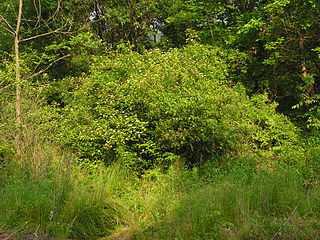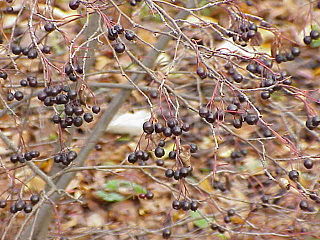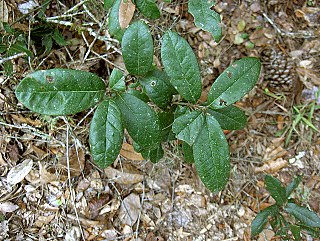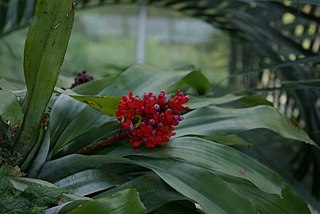
The Caprifoliaceae or honeysuckle family is a clade of dicotyledonous flowering plants consisting of about 860 species in 42 genera, with a nearly cosmopolitan distribution. Centres of diversity are found in eastern North America and eastern Asia, while they are absent in tropical and southern Africa.
Paw Paw, Paw paw, or pawpaw may refer to:

Kalmia is a genus of about ten species of evergreen shrubs from 0.2–5 m tall, in the family Ericaceae. They are native to North America and Cuba. They grow in acidic soils, with different species in wet acid bog habitats and dry, sandy soils.

The Connecticut College Arboretum is a 300 ha arboretum and botanical gardens, founded in 1931, and located on the campus of Connecticut College and in the towns of New London and Waterford, Connecticut, United States.

Calycanthus (sweetshrub) is a genus of flowering plants in the family Calycanthaceae, endemic to North America. The genus includes two to four species depending on taxonomic interpretation; two are accepted by the Flora of North America.

Shrub-steppe is a type of low rainfall natural grassland. While arid, shrub-steppes have sufficient moisture to support a cover of perennial grasses and/or shrubs, a feature which distinguishes them from deserts.

Vaccinium corymbosum, the northern highbush blueberry, is a North American species of blueberry which has become a food crop of significant economic importance. It is native to eastern Canada and the eastern and southern United States, from Ontario east to Nova Scotia and south as far as Florida and eastern Texas. It is also naturalized in other places: Europe, Japan, New Zealand, the Pacific Northwest of North America, etc. Other common names include blue huckleberry, tall huckleberry, swamp huckleberry, high blueberry, and swamp blueberry.

Cephalanthus occidentalis is a species of flowering plant in the coffee family, Rubiaceae, that is native to eastern and southern North America. Common names include buttonbush, common buttonbush, button-willow and honey-bells.
Buttonbush is a common name for several plants and may refer to:

Aronia arbutifolia, called the red chokeberry, is a North American species of shrubs in the rose family. It is native to eastern Canada and to the eastern and central United States, from eastern Texas to Nova Scotia inland to Ontario, Ohio, Kentucky, and Oklahoma.

Aronia melanocarpa, called the black chokeberry, is a species of shrubs in the rose family native to eastern North America, ranging from Canada to the central United States, from Newfoundland west to Ontario and Minnesota, south as far as Arkansas, Alabama, and Georgia. This plant has been introduced and is cultivated in Europe.

Cornus amomum, the silky dogwood or kinnikinnik, is a species of dogwood native to eastern North America, from Ontario and Quebec south to Arkansas and Georgia. It is also found in other parts of North America. Other names for this dogwood have included red willow, silky cornel, and squawbush.

Baccharis halimifolia is a North American species of shrubs in the daisy family. It is native to Nova Scotia, the eastern and southern United States, eastern Mexico, the Bahamas, and Cuba.

Aronia prunifolia, called the purple chokeberry, is a North American species of shrubs in the rose family. It is native to eastern Canada and to the eastern and central United States, from Nova Scotia west to Ontario and Wisconsin, south as far as western South Carolina with an isolated population reported in southern Alabama.
Odoratus is a Latin adjective meaning "fragrant, perfumed", and may refer to:

Quercus minima, the dwarf live oak or minimal oak, is a North American species of shrubs in the beech family. It is native to the southeastern United States.

Greasewood is a common name shared by several plants:

Hypericum crux-andreae, commonly called St. Peter's-wort, is a small shrub in the St. John's wort family. It is native to Eastern North America, where it is primarily found in the sandy soils of the Coastal Plain with extensions into the Piedmont and Cumberland Plateau.

Hypericum lobocarpum, commonly called fivelobe St. Johnswort, is a species of flowering plant in the St. Johnswort family (Hypericaceae). It is native eastern to North America, where it is found primarily in the western portion of the southeastern United States. Its typical natural habitat is in open wet areas, such as stream banks, lake margins, swamps, and pine savannas.


















